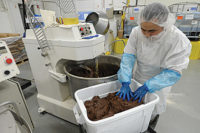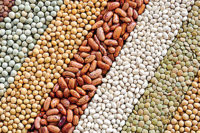manufacturing plant.

Marina Mayer, Executive Editor
Since 1974, Shearer’s Foods has been epitomizing “Shearer Perfection,” which is “the art of snacking and science of product, support, merchandising and corporate culture,” according to the Brewster, Ohio, snack manufacturer. “Shearer Perfection” is also about customer loyalty, a rich family culture and “goodness beyond the bag,” says the company’s motto.
That’s why the 1,500-employee snack manufacturing empire receivedSnack Food & Wholesale Bakery’sSnack Manufacturer of the Year award. That, and also because it developed the first Leadership in Energy and Environmental Design (LEED) Platinum snack manufacturing facility in the world, known as the Millennium Plant.
“From a manufacturing standpoint, we’ve taken what we’ve learned from our other plants and designed this [plant] straight from a blank sheet of paper,” says Ken Brower, director of operations for both the Massillon and Brewster locations.
Snack Food & Wholesale Bakery was invited to tour the 110,200-sq.-ft., LEED-certified Massillon, Ohio, facility, which opened in April 2010, and boasts nine production and 20 packaging lines.
On the tortilla chip side of the plant, Shearer’s Foods was producing yellow corn Deli-Style tortilla chips with sea salt at 3,000 lb. an hour.
The production process starts with truckloads of blue or yellow corn that are stored in 250,000-lb. silos. From there, corn travels through a batch hopper and into a clipper cleaner, which helps filter out the broken corn, Brower says.
“In our cooking process, lime is added, which helps the kernel expand and absorb some moisture,” Brower says.
Next, the corn goes through one of two, 1,500-lb./batch corn-cook kettles that are steam-jacketed and well insulated to retain heat.
“We do recycle the pre-heat, or cook water, with energy that we’ve recovered from the oven,” Brower adds. Additionally, the cooking process is designed to save 180 gallons of water for each cycle.
Corn is then soaked for nine to 11 hours in one of the 12 3,000-lb. soaking tanks before entering the washing room, where it is pumped upstairs through a drain belt for about four minutes before entering a grinder.
“The grinder is the first area mechanically where we can start adjusting the texture of the product depending on the opening of the gap of the grind,” Brower says. “We can make a very flaky tortilla or a really robust tortilla that will hold a bunch of salsa, depending on what the customer is asking for.”
After leaving the grinder, masa, or ground corn dough, comes through a transfer tube and drops into a sheeter, which forms the masa into a specified thickness. Then the masa travels through a cutter that forms the product into shapes, “like a little army of tortilla chips, marching into the oven,” Brower adds.
Next, the chips enter a triple-pass oven, which is considered “one of the centerpieces of the energy-savings of the plant,” Brower says. “This is a one-of-a-kind, patent-pending oven. It has 24 infrared heating units on the inside, and has little drafting with the exception of where the chips come in and where the chips come out.” The oven also pre-heats combustion air using the infrastructure as conduits for this supply. The combination of these innovations results in gas savings of more than 47% when compared to competing technologies.
Chips begin baking at the top of the oven and travel through to the bottom for about 30-40 seconds. Off of the tortilla oven is a liquid chimney. Previously wasted thermal energy from the oven stack is redirected to a skid where a combination of water, glycol and heat exchangers are used to recapture this heat. This energy then supplies more than 92% of the building heating load, as well as pre-heats water for corn cooking and sanitation, Brower says.
Next, the chips convey on an equilibrating belt, where they rest and cool before being sent into a three-well fryer.
“We have a continuous filtration system in the fryer with turnover of less than eight hours,” Brower says.
The chips then travel into a weigh scale, which electronically informs the seasoner how much seasoning to add into the seasoning bowl.
“Historically, it’s been based on infrareds, but this actually weighs it so we’re getting a 1:1 ratio between the amount of weight we want in there and the proportion of seasoning going in,” Brower notes.
After seasoning, the chips travel along a 45-ft.-long conveyor into a packaging room where they funnel into vibrational conveyors, drop into form/fill/seal baggers and the bags are then manually bundled.
On the other side of the building lies the twin-screw line, which produces 800 lb. of product an hour. At the time ofSnack Food & Wholesale Bakery’svisit, Shearer’s Foods was producing whole grain chips.
Ingredients come in 50-lb. bags and are screened into a batch mixer on an upper level before dropping down into a batch hopper.
The mixture then processes through the twin screw extruder, where temperature is controlled from 60-120°C. A specially-made die produces a hot ribbon of product, which is then cooled and cut before entering the fryer.
“All of our heat exchangers use oxygen trimming, which optimizes the ratio of gas and air for cleaner, more efficient combustion,” Brower notes.
Lastly, chips exit and travel to the seasoning room upstairs where they are seasoned, conveyed, then transferred into the form/fill/seal arena where they are bagged and manually bundled.
The sustainability factor
Constructing a sustainable facility was key to taking the company to the next phase of growth, says Bob Shearer, chairman, co-founder and CEO. That’s why installing state-of-the-art equipment, controls and lines was necessary to achieve the sustainability factor.
For starters, all of the lines use computer-controlled touchscreens that act as surveillance systems for the lines, allowing the plant to be operated with minimal staffing.
“If I’m running this line, and I want to see what’s going on in the fryer downstairs, I just push the buttons, pull up [some information] and I can make any adjustments I need to,” Brower says. “This helps the quality of our products because we have a lot of sensors and a lot of readings on this that give us real-time feedback. They’re controlled within a certain capacity, whereas before, we didn’t have this type of feedback or controls.”
The LEED-certified plant also is home to rainwater harvesting, which allows for 60% savings in water. Rainwater collects from the roof, runs through a triple filtration system, is stored in a 1,200-gallon tank and is used for the plant’s non-potable applications, such as flushing toilets.
In the snack food quality lab, operators conduct titrate tests every 45 minutes on each line. Meanwhile, in the Infinity quality system, virtual program management officers (VPMOs) perform a series of checks in which the product being tested must pass all tests in order for the batch to be shipped out. In addition, the product inspection team (PIT) conducts a PIT test every two hours.
“We grab a bag off of every line, open it up in a room and look at it for appearance, taste and texture,” Brower says. “We have a cross-functional team of processors, packagers, lab people and supervisors, and we’re grading it on a scale of zero to five, zero is gold standard-the best. Anything over three, we won’t ship and we have immediate action out on the line. We’re very picky about our product.”
The facility also conducts mock recalls twice a year and maintains a 965 AIB score. It also features six docks, where product is picked up once every two hours and taken to the Shearer’s Food’s distribution center down the road. As the Millennium Plant comes online, Shearer’s Foods is opting to dial down its production shifts from six days to five, so as not to overwork our associates, Brower adds.
Shearer perfection
“First and foremost, [Shearer Perfection] is about the people, no doubt,” he adds. “I don’t know of anyone who could match our workforce. We’re very open with each other. Through training programs and various meetings, we help our associates do their job perfectly every time.”
That’s why the folks at Shearer’s Foods continue to LEED the way.



